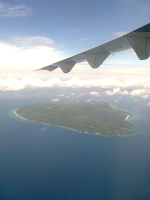Suman is a Philippine desssert or
merienda that's made from sticky glutenous rice cooked in salted coconut milk extract (called
gata) and water. It is conveniently wrapped in a cut banana leaf which makes it easy to eat like a banana. Suman is sticky and oily so one may need some napkins while eating them. Nevertheless, suman can be so delicious you may just do away with the tissue paper!
Suman starts out as rice that's cooked in coconut milk (
gata) until soft and sticky. The coconut milk gives a pleasant and appetizing taste to the suman. If you want the suman to be sweet, you can add sugar to the mixture. A simple rice cooker can be used to prepare the suman. But the product wouldn't be "suman" is if isn't wrapped in banana leaves! If that's the case, that would be
kakanin (local sticky sweets made of rice) similar to another Filipino delicacy called
biko, which is laid on a
bilao (flat woven basket) and sliced diagonally into square or diamond sections.
The banana wrapper can be sourced from locally-growing banana plants. Otherwise, the leaves can be bought already prepared from grocery stores and the community market (
palengke). If you want to prepare your own banana leaves. cut them into squares just big enough for your suman. The pieces are then heated over an open flame to soften them up. The leaves will turn darker over the flames but do not let them burn!
To wrap the suman, take spoonfulls and drop them into each leaf. Each should appear like paste from a tube and should be big enough to be held in one hand. After the suman rice are all wrapped, place them in a pot filled with water and allow to boil. You should then let it simmer for about 30 minutes, after which the suman should be done. You may prefer to cook your suman rice without sugar. You can just add coco jam to your cooked suman for flavor while you eat!
Learn about the Philippine sweet potato or kamote
This freeloader fork is perfect for those times when you fear there won't be enough food left for you. It's ideal for hotdogs, sausages, and suman!
Click here or on the image to order this fine freeloader fork that expands up to 2 feet!
How can you grow money with GeoString?

















































